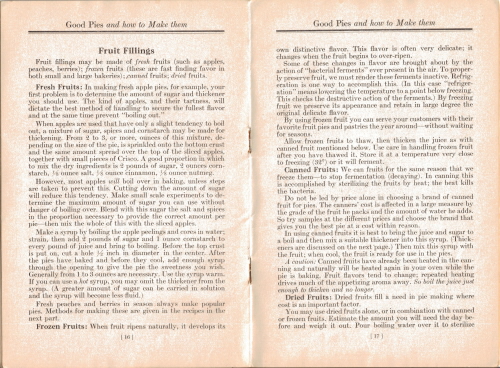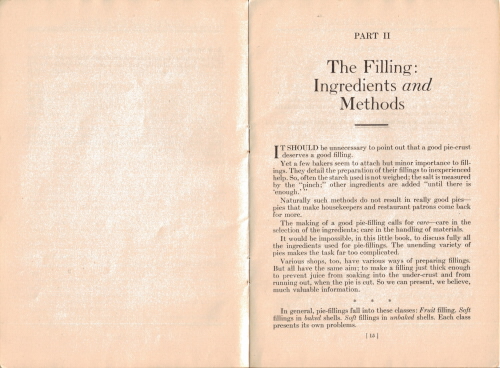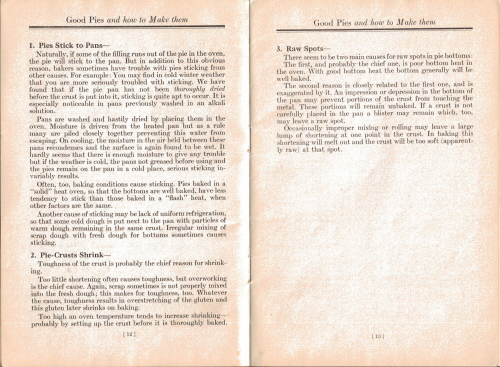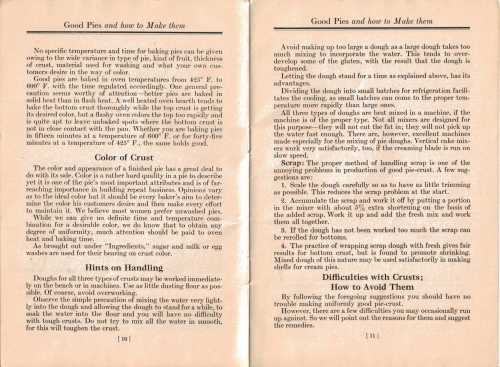 Here are pages 16 and 17 of the vintage recipe booklet “Good Pies & How To Make Them” that was published in 1928 by Crisco.
Here are pages 16 and 17 of the vintage recipe booklet “Good Pies & How To Make Them” that was published in 1928 by Crisco.
To review all pages in this booklet, simply visit the Crisco: Good Pies & How To Make Them Category and click on a page title to review that section.
There are scans available of each page, just click the images to view a full size copy.
Fruit Fillings
Fruit fillings may be made of fresh fruits (such as apples, peaches, berries); frozen fruits (these are fast finding favor in both small and large bakeries); canned fruits; dried fruits.
Fresh Fruits: In making fresh apple pies, for example, your first problem is to determine the amount of sugar and thickener you should use. The kind of apples, and their tartness, will dictate the best method of handling to secure the fullest flavor and at the same time prevent “boiling out.”
When apples are used that have only a slight tendency to boil out, a mixture of sugar, spices and cornstarch may be made for thickening. From 2 to 3, or more, ounces of this mixture, depending on the size of the pie, is sprinkled onto the bottom crust and the same amount spread over the top of the sliced apples, together with small pieces of Crisco. A good proportion in which to mix the dry ingredients is 2 pounds of sugar, 2 ounces cornstarch, 1/8 ounce salt, 1/8 ounce cinnamon, 1/8 ounce nutmeg.
However, most apples will boil over in baking, unless steps are taken to prevent this. Cutting down the amount of sugar will reduce this tendency. Make small scale experiments to determine the maximum amount of sugar you can use without danger of boiling over. Blend with this sugar the salt and spices in the proportion necessary to provide the correct amount per pie–then mix the whole of this with the sliced apples.
Make a syrup by boiling the apple peelings and cores in water; strain, then add 2 pounds of sugar and 1 ounce cornstarch to every pound of juice and bring to boiling. Before the top crust is put on, cut a hole 1/2 inch in diameter in the center. After the pies have baked and before they cool, add enough syrup through the opening to give the pie the sweetness you wish. Generally from 1 to 3 ounces are necessary. Use the syrup warm. If you can use a hot syrup, you may omit the thickener from the syrup. (A greater amount of sugar can be carried in solution and the syrup will become less fluid.)
Fresh peaches and berries in season always make popular pies. Methods for making these are given in the recipes in the next part.
Frozen Fruits: When fruit ripens naturally, it develops its own distinctive flavor. This flavor is often very delicate; it changes when the fruit begins to over-ripen.
Some of these changes in flavor are brought about by the action of “bacterial ferments” ever present in the air. To properly preserve fruit, we must render these ferments inactive. Refrigeration is one way to accomplish this. (In this case “refrigeration” means lowering the temperature to a point below freezing. This checks the destructive action of the ferments.) By freezing fruit we preserve its appearance and retain in large degree the original delicate flavor.
By using frozen fruit you can serve your customers with their favorite fruit pies and pastries the year around–without waiting for seasons.
Allow frozen fruits to thaw, then thicken the juice as with canned fruit mentioned below. Use care in handling frozen fruit after you have thawed it. Store it at a temperature very close to freezing (32°) or it will ferment.
Canned Fruits: We can fruits for the same reason that we freeze them–to stop fermentation (decaying). In canning this is accomplished by sterilizing the fruits by heat; the heat kills the bacteria.
Do not be led by price alone in choosing a brand of canned fruit for pies. The canners’ cost is affected in a large measure by the grade of the fruit he packs and the amount of water he adds. So try samples at the different prices and choose the brand that gives you the best pie at a cost within reason.
In using canned fruits it is best to bring the juice and sugar to a boil and then mix a suitable thickener into this syrup. (Thickeners are discussed on the next page.) Then mix this syrup with the fruit; when cool, the fruit is ready for use in the pies.
A caution: Canned fruits have already been heated in the canning and naturally will be heated again in your oven while the pie is baking. Fruit flavors tend to change; repeated heating drives much of the appetizing aroma away. So boil the juice just enough to thicken and no longer.
Dried Fruits: Dried fruits fill a need in pie making where cost is an important factor.
You may use dried fruits alone, or in combination with canned or frozen fruits. Estimate the amount you will need the day before and weigh it out. Pour boiling water over it to sterilize it, then wash with cold water and allow to soak about 12 hours. Drain off any surplus water and to the remainder add sugar and thickener as in the case of canned fruit.
 Here are pages 14 and 15 of the vintage recipe booklet “Good Pies & How To Make Them” that was published in 1928 by Crisco (page 14 is blank).
Here are pages 14 and 15 of the vintage recipe booklet “Good Pies & How To Make Them” that was published in 1928 by Crisco (page 14 is blank).
To review all pages in this booklet, simply visit the Crisco: Good Pies & How To Make Them Category and click on a page title to review that section.
There are scans available of each page, just click the images to view a full size copy.
Part II
The Filling: Ingredients and Methods
It should be unnecessary to point out that a good pie-crust deserves a good filling.
Yet a few bakers seem to attach but minor importance to fillings. They detail the preparation of their fillings to inexperienced help. So, often the starch used is not weighed; the salt is measured by the “pinch;” other ingredients are added “until there is ‘enough.’ ”
Naturally such methods do not result in really good pies–pies that make housekeepers and restaurant patrons come back for more.
The making of a good pie-filling calls for care–care in the selection of the ingredients; care in the handling of materials.
It would be impossible, in this little book, to discuss fully all the ingredients used for pie-fillings. The unending variety of pies makes the task far too complicated.
Various shops, too, have various ways of preparing fillings. But all have the same aim; to make a filling just thick enough to prevent juice from soaking into the under-crust and from running out, when the pie is cut. So we can present, we believe, much valuable information.
In general, pie-fillings fall into these classes: Fruit filling. Soft fillings in baked shells. Soft fillings in unbaked shells. Each class presents its own problems.
 Here are pages 11 (part), 12 and 13 of the vintage recipe booklet “Good Pies & How To Make Them” that was published in 1928 by Crisco.
Here are pages 11 (part), 12 and 13 of the vintage recipe booklet “Good Pies & How To Make Them” that was published in 1928 by Crisco.
To review all pages in this booklet, simply visit the Crisco: Good Pies & How To Make Them Category and click on a page title to review that section.
There are scans available of each page, just click the images to view a full size copy.
Difficulties with Crusts; How to Avoid Them
By the following the foregoing suggestions you should have no trouble making uniformly good pie-crust.
However, there are a few difficulties you may occasionally run up against. So we will point out the reasons for them and suggest the remedies.
1. Pies Stick to Pans–
Naturally, if some of the filling runs out of the pie in the oven, the pie will stick to the pan. But in addition to this obvious reason, bakers sometimes have trouble with pies sticking from other causes. For example: You may find in cold winter weather that you are more seriously troubled with sticking. We have found that if the pie pan has not been thoroughly dried before the crust is put into it, sticking is quite apt to occur. It is especially noticeable in pans previously washed in an alkali solution.
Pans are washed and hastily dried by placing them in the oven. Moisture is driven from the heated pan but as a rule many are piled closely together preventing this water from escaping. On cooling, the moisture in the air held between these pans recondenses and the surface is again found to be wet. It hardly seems that there is enough moisture to give any trouble but if the weather is cold, the pans not greased before using and the pies remain on the pan in a cold place, serious sticking invariably results.
Often, too, baking conditions cause sticking. Pies baked in a “solid” heat oven, so that the bottoms are well baked, have less tendency to stick than those baked in a “flash” heat, when other factors are the same.
Another cause of sticking may be lack of uniform refrigeration, so that some cold dough is put next to the pan with particles of warm dough remaining in the same crust. Irregular mixing of scrap dough with fresh dough for bottoms sometimes causes sticking.
2. Pie-Crusts Shrink–
Toughness of the crust is probably the chief reason for shrinking.
Too little shortening often causes toughness, but overworking is the chief cause. Again, scrap sometimes is not properly mixed into the fresh dough; this makes for toughness, too. Whatever the cause, toughness results in overstretching of the gluten and this gluten later shrinks on baking.
Too high an oven temperature tends to increase shrinking–probably by setting up the crust before it is thoroughly baked.
3. Raw Spots–
There seem to be two main causes for raw spots in pie bottoms:
The first, and probably the chief one, is poor bottom heat in the oven. With good bottom heat the bottom generally will be well baked.
The second reason is closely related to the first one, and is exaggerated by it. An impression or depression in the bottom of the pan may prevent portions of the crust from touching the metal. These portions will remain unbaked. If a crust is not carefully placed in the pan a blister may remain which, too, may leave a raw spot.
Occasionally improper mixing or rolling may leave a large lump of shortening at one point in the crust. In baking this shortening will melt out and the crust will be too soft (apparently raw) at that spot.
 Here is part of page 10 and 11 of the vintage recipe booklet “Good Pies & How To Make Them” that was published in 1928 by Crisco.
Here is part of page 10 and 11 of the vintage recipe booklet “Good Pies & How To Make Them” that was published in 1928 by Crisco.
To review all pages in this booklet, simply visit the Crisco: Good Pies & How To Make Them Category and click on a page title to review that section.
There are scans available of each page, just click the images to view a full size copy.
Hints on Handling
Doughs for all three types of crusts may be worked immediately on the bench or in machines. Use as little dusting flour as possible. Of course, avoid overworking.
Observe the simple precaution of mixing the water very lightly into the dough and allowing the dough to stand for a while, to soak the water into the flour and you will have no difficulty with tough crusts. Do not try to mix all the water in smooth, for this will toughen the crust.
Avoid making up too large a dough as a large dough takes too much mixing to incorporate the water. This tends to over-develop some of the gluten, with the result that the dough is toughened.
Letting the dough stand for a time as explained above, has its advantages.
Dividing the dough into small batches for refrigeration facilitates the cooling, as small batches can come to the proper temperature more rapidly than large ones.
All three types of doughs are best mixed in a machine, if the machine is of the proper type. Not all mixers are designed for this purpose–they will not cut the fat in; they will not pick up the water fast enough. There are, however, excellent machines made especially for the mixing of pie doughs. Vertical cake mixers work very satisfactorily, too, if the creaming blade is run on slow speed.
Scrap: The proper method of handling scrap is one of the annoying problems in production of good pie-crust. A few suggestions are:
- Scale the dough carefully so as to have as little trimming as possible. This reduces the scrap problem at the start.
- Accumulate the scrap and work it off by putting a portion in the mixer with about 5% extra shortening on the basis of the added scrap. Work it up and add the fresh mix and work them all together.
- If the dough has not been worked too much the scrap can be rerolled for bottoms.
- The practice of wrapping scrap dough with fresh gives fair results for bottom crust, but is found to promote shrinking. Mixed dough of this nature may be used satisfactorily in making shells for cream pies.
 Here is part of page 10 of the vintage recipe booklet “Good Pies & How To Make Them” that was published in 1928 by Crisco.
Here is part of page 10 of the vintage recipe booklet “Good Pies & How To Make Them” that was published in 1928 by Crisco.
To review all pages in this booklet, simply visit the Crisco: Good Pies & How To Make Them Category and click on a page title to review that section.
There are scans available of each page, just click the images to view a full size copy.
Color of Crust
The color and appearance of a finished pie has a great deal to do with its sale. Color is a rather hard quality in a pie to describe yet it is one of the pie’s most important attributes and is of far-reaching importance in building repeat business. Opinions vary as to the ideal color but it should be every baker’s aim to determine the color his customers desire and then make every effort to maintain it. We believe most women prefer unwashed pies.
While we can give no definite time and temperature combination for a desirable color, we do know that to obtain any degree of uniformity, much attention should be paid to oven heat and baking time.
As brought out under “Ingredients,” sugar and milk or egg washes are used for their bearing on crust color.
 Here is part of pages 9 and 10 of the vintage recipe booklet “Good Pies & How To Make Them” that was published in 1928 by Crisco.
Here is part of pages 9 and 10 of the vintage recipe booklet “Good Pies & How To Make Them” that was published in 1928 by Crisco.
To review all pages in this booklet, simply visit the Crisco: Good Pies & How To Make Them Category and click on a page title to review that section.
There are scans available of each page, just click the images to view a full size copy. Since this is just a small part of two pages (9 and 10), no scan will be included here, just look on the next page for a scan (Hints on Handling).
Baking
The old saying among journeymen bakers, “when they’re black, they’re done,” does not hold true with pies. It is possible to bake pies having a heavy egg wash in a flashy oven so they may be black, yet not have the bottom crust properly baked.
No specific temperature and time for baking pies can be given owing to the wide variance in type of pie, kind of fruit, thickness of crust, material used for washing and what your own customers desire in the way of color.
Good pies are baked in oven temperatures from 425° F. to 600° F. with the time regulated accordingly. One general precaution seems worthy of attention–better pies are baked in solid heat than in flash heat. A well heated oven hearth tends to bake the bottom crust thoroughly while the top crust is getting its desired color, but a flashy oven colors the top too rapidly and is quite apt to leave unbaked spots where the bottom crust is not in close contact with the pan. Whether you are baking pies in fifteen minutes at a temperature of 600° F. or for forty-five minutes at a temperature of 425° F., the same holds good.
 Here is part of page 9 of the vintage recipe booklet “Good Pies & How To Make Them” that was published in 1928 by Crisco.
Here is part of page 9 of the vintage recipe booklet “Good Pies & How To Make Them” that was published in 1928 by Crisco.
To review all pages in this booklet, simply visit the Crisco: Good Pies & How To Make Them Category and click on a page title to review that section.
There are scans available of each page, just click the images to view a full size copy.
Refrigeration
Refrigeration is not essential in the making of the Short-Mealy type of crust, because the fat is so thoroughly distributed throughout the dough. You gain a better distribution of the water by permitting the dough to stand one or two hours before rolling.
 In making the Flaky pie-crust, refrigeration is of advantage. Refrigeration “sets” the lumps of Crisco and gives them a better consistency for rolling into flakes. The time allowed for refrigeration also permits the water to distribute itself throughout the dough.
In making the Flaky pie-crust, refrigeration is of advantage. Refrigeration “sets” the lumps of Crisco and gives them a better consistency for rolling into flakes. The time allowed for refrigeration also permits the water to distribute itself throughout the dough.
In making the Short-Flaky type of crust, refrigeration gives you the same advantages as when you make the Flaky crust. But it is not so important.
If doughs for either the Flaky crust or the Short-Flaky crust are allowed to stand in a warm shop the fat will soften and work through the dough. This would change a Flaky or a Short-Flaky crust into a Short-Mealy crust.
 Here is part of page 8 and part of page 9 of the vintage recipe booklet “Good Pies & How To Make Them” that was published in 1928 by Crisco.
Here is part of page 8 and part of page 9 of the vintage recipe booklet “Good Pies & How To Make Them” that was published in 1928 by Crisco.
To review all pages in this booklet, simply visit the Crisco: Good Pies & How To Make Them Category and click on a page title to review that section.
There are scans available of each page, just click the images to view a full size copy.
Methods of Mixing
1. Short-Mealy Crust: To produce a Short-Mealy crust, obtain a thorough distribution of the fat throughout the flour. To accomplish this, take one-half of the flour and all of the Crisco, and mix thoroughly. Then add the balance of the flour and mix it in to break up the creamed mass. This requires little mixing. Add the cold water last and mix just enough to incorporate it.
 2. Flaky Crust: You can obtain a Flaky crust by lightly mixing all the Crisco with all the flour so that you obtain an irregular mixture, with little lumps of fat throughout it. Then add the cold water and mix very little. This dough will require slightly more water than the dough for the Short-Mealy crust in order to make a dough of the same consistency. This is because less flour has been coated with fat–the flour is free to absorb moisture. When the dough is rolled out, the little lumps of fat throughout the dough are rolled out into layers between the layers of dough. This causes the “flake.” It is advantageous to have the shortening cool so that it will break into lumps. This dough should be handled at not over 65° F.
2. Flaky Crust: You can obtain a Flaky crust by lightly mixing all the Crisco with all the flour so that you obtain an irregular mixture, with little lumps of fat throughout it. Then add the cold water and mix very little. This dough will require slightly more water than the dough for the Short-Mealy crust in order to make a dough of the same consistency. This is because less flour has been coated with fat–the flour is free to absorb moisture. When the dough is rolled out, the little lumps of fat throughout the dough are rolled out into layers between the layers of dough. This causes the “flake.” It is advantageous to have the shortening cool so that it will break into lumps. This dough should be handled at not over 65° F.
3. Short-Flaky Crust: To make the Short-Flaky crust, mix one-half of the Crisco with all of the flour until you obtain a thorough distribution of the fat. Then add the other half of the Crisco and mix it in lightly–so that it is left in little lumps throughout the dough. Next add the cold water and mix lightly.
The dough for the Short-Flaky crust is really a composite mixture (that is, flour coated with fat is surrounding lumps of fat). The first half of the shortening, distributed throughout the flour, produces shortness (as in the method for making a Short-Mealy crust). The last half of the shortening, in little lumps throughout the dough produces the flaky effect (as in the method for making the Flaky type of crust).
The Flaky crust method will often produce a crust similar to the Short-Flaky crust–if the shortening is soft enough to work into the flour and at the same time has body enough to form some lumps throughout the dough.






